The best bee-pollinated cucumbers for growing in open ground and greenhouses: top 18 varieties and hybrids
Today, the cucumber seed market has been flooded with parthenocarpic hybrids that have only female flowers that do not require pollination to produce fruit. But many summer residents still remain faithful to traditions and grow exactly bee-pollinated cucumbers, while novice gardeners do not quite understand what the meaning of such an action is. But parthenocarpic and bee-pollinated varieties and hybrids can quite complement each other (for example, the former are more for a greenhouse, the latter are for open ground).
Next, let's talk in more detail about what bee-pollinated cucumbers are, why they should be grown, how to do it correctly, what are the nuances and features of care. In addition, your attention will be provided with a list of the most popular and best bee-pollinated varieties and hybrids of cucumbers intended for growing in the open field (primarily) and in the greenhouse.
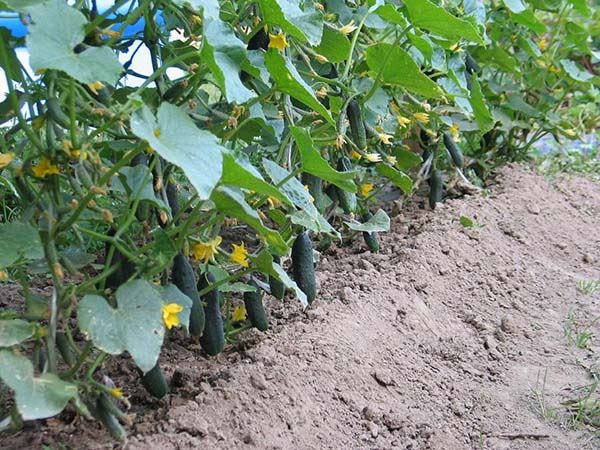
Content
What are bee-pollinated cucumbers and what are the advantages of growing them
It is not hard to guess that bee-pollinated cucumbers set fruits only after pollination by pollinating insects, for example, bees or bumblebees.
By the way! You can also carry out pollination manually - pick a male flower and poke on female flowers, only in the early morning (before the heat).
You can pollinate with a brush or cotton swab.
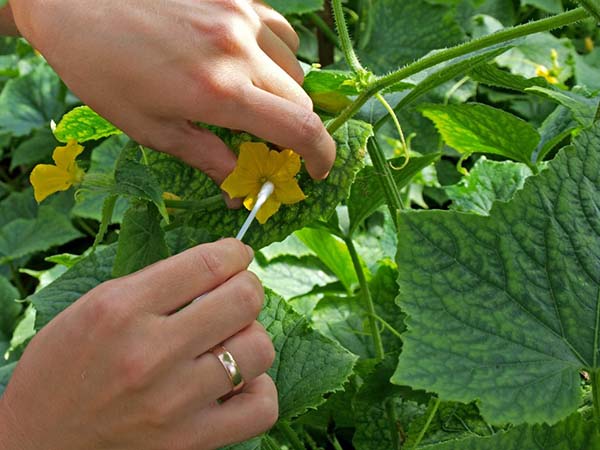
It would seem, why do you need unnecessary problems, it is much easier to plant self-pollinated cucumbers and "not to steam". But bee-pollinated varieties and hybrids still have quite serious advantages:
- They tend to be tastier and more aromatic.
- They are more useful, since due to the forming seeds they have an increased content of biologically active substances, vitamins and carbohydrates.
- Ideal for pickling and preserving.
- They can give a decent harvest even in relatively shady areas of the garden.
By the way! Of course, shade-tolerant and very tasty self-pollinated hybrids have long been bred (they are more tender, they do not have seeds), but many gardeners still continue to grow exactly bee-pollinated cucumbers. Perhaps everyone has their own opinion on this matter.
Features of growing bee-pollinated cucumbers
The cultivation of bee-pollinated cucumbers has some nuances:
- If you have a bee-pollinated hybrid with a female type of flowering, then it is recommended to plant a pollinator plant nearby in a ratio of 10: 1, in other words, there should be 1 pollinator per 10 female plants... In this case, the planting scheme is not important - the main thing is that these plants (female and male) grow together in the same garden bed (greenhouse).
As a rule, the instructions on the back of the pack indicate that 10% of the pollinator should be added to the “hybrid name”.
In a pack of seeds, a pollinator cucumber seed is sometimes attached. Or you will have to purchase seeds of pollinator hybrids on your own, for example, Nectar F1, Bumblebee F1 (Manul).
- Pollination of cucumbers provided exclusively by insects pollinators (bees, bumblebees). The presence or absence of wind (for example, if you have calm weather) does not affect pollination cucumbers, which means their not necessary specially (with your own hand) to shake.
Note! The only thing that can negatively affect the quality of pollination of cucumbers is unfavorable weather conditions that limit the actions (years) of pollinating insects, for example, rain, low temperatures, etc.
- Bee-pollinated and parthenocarpic cucumbers must not be grown in the same garden bed (greenhouse), otherwise, with such a joint planting, the greens will turn out to be crooked and ugly, as well as, as a rule, pear-shaped (bottle-shaped). The fact is that pollinating insects (bees, bumblebees) will, among other things, also pollinate the flowers of parthenocarpic cucumbers, which do not need it and will only harm them.
In addition, bee-pollinated cucumbers have features during formation (pinching, pinching)... This is clearly shown and told by a popular gardener blogger in the next video.
Video: the formation of bee-pollinated cucumbers in the greenhouse
The best bee-pollinated hybrids and varieties of cucumbers for open ground and greenhouses
A survey list of the best bee-pollinated cucumbers was prepared based on the degree of popularity of the names of hybrids and varieties, on the reviews of experienced gardeners, as well as on the author's personal opinion.
The most popular and best bee-pollinated varieties and hybrids of cucumbers (alphabetically):
Note! Naturally, bee-pollinated cucumbers are primarily intended for growing in the open field, but this does not mean at all that they cannot be grown in closed ground (greenhouses and greenhouses). Moreover, in such conditions, they most often give an even more bountiful harvest.
Important! The descriptions provide recommendations on the place (method) of growing this or that hybrid and variety.
Bee-pollinated cucumber hybrids: top 10
No hassle F1
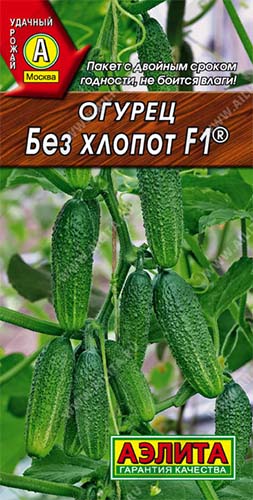
- Early maturing bee-pollinated hybrid (40-44 days from germination to fruiting).
- The plant is indeterminate, medium branched, the number of female flowers in a node is 2.
- For growing in the open field and under film shelters.
- Fruit is cylindrical, small tuberous, pubescence is white, dense.
- Length - 8-10 cm, weight - 90-100 g.
- Productivity - up to 13-14 kg per sq. m.
- The taste is excellent. No voids or bitterness, crispy.
- The fruits are used fresh, for pickling and for pickling at the beginning of the harvest season.
- Cladosporium resistant, moderately resistant to cucumber mosaic virus, powdery mildew and downy mildew.
Loyal friends F1
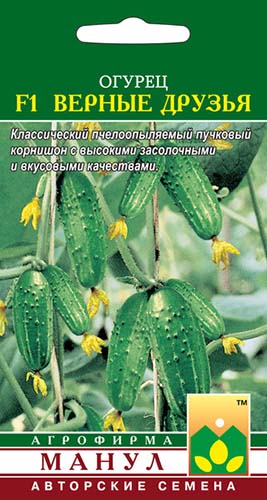
- Early maturing bee-pollinated hybrid. It starts bearing fruit on the 37-39 day after germination.
- The plant is climbing, indeterminate, weakly growing, mainly of the female flowering type. Bundle ovary from 2-3 to 5-8 or more ovaries are formed in the nodes.
- For open ground, tunnels, spring greenhouses.
- The fruits are tuberous, black-spiky, oval-cylindrical in shape.
- Length - 8-10 cm, diameter - 3.5-4.1 cm, weight - 90-105 g.
- Productivity - 2.5-3 kg per sq. m (in the open field).
- Salting and taste qualities are very high.
- Cold hardy, resistant to olive spot, cucumber mosaic virus, tolerant to powdery mildew and downy mildew.
Hector F1
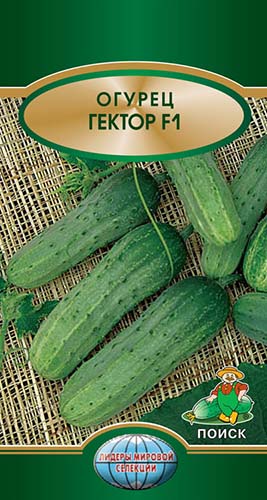
- Early maturing bee-pollinated hybrid.
- The plant is determinant, bush, compact, predominantly female flowering type.
- For growing in the open field.
- The fruit is cylindrical, green, large tubercles (sparse tubercles), white pubescence.
- Weight - 95-100 g, length - 10-12 cm, diameter - 3.0-3.3 cm.
- Productivity - up to 3.94 kg per sq.m.
- The taste is excellent.
- Universal: salad, canning.
- Resistant to olive spot, cucumber mosaic virus, powdery mildew.
Kids on the F1 branch
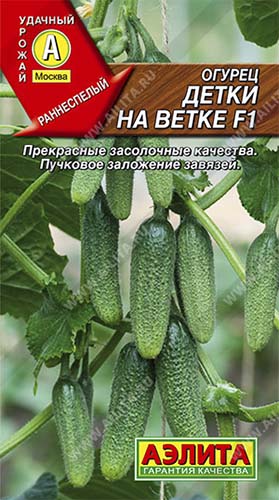
- Early maturing bee-pollinated hybrid (from germination to the beginning of fruiting 42-45 days).
- The plant is indeterminate, vigorous, medium-branched, predominantly female flowering type. Bundle ovary, in the bosom of each leaf, 2-3 cucumbers are simultaneously formed.
- Recommended for growing in open ground and under cover films.
- The fruit is short, cylindrical, small tuberous; pubescence is white, dense.
- Weight - 90-100 g.
- Productivity - up to 10-11 kg per sq. meter (in the greenhouse).
- Excellent taste, not bitter, no voids, juicy and crunchy.
- Universal use: great fresh, in salads, perfect for all types of pickling and pickling.
Brownie F1
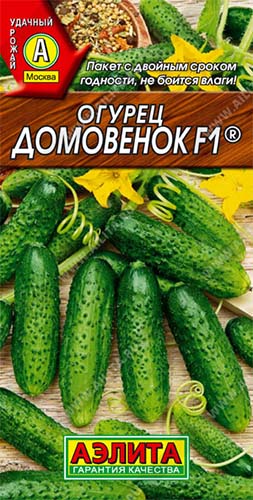
- Medium early bee-pollinated hybrid, the period from germination to fruiting 45-48 days.
- The plant is indeterminate, medium-sized, medium-branched.
- Designed for growing in open ground and under film shelters.
- Fruits are short, even, fusiform, large tuberous, white pubescence, of medium density.
- Length - 6-9 cm, weight - 80-110 g.
- Productivity - up to 10-11 kg per sq. meter.
- Excellent taste, crunchy, no bitterness, no yellowing.
- Excellent fresh, salted and pickled.
- Resistant to cladosporium, true and downy mildew.
Kumanek F1
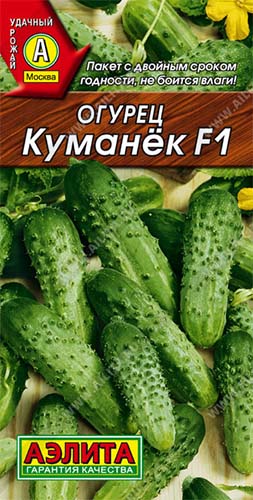
- Medium early bee-pollinated hybrid, the period from germination to the beginning of fruiting is 45-48 days.
- Plants are indeterminate, medium-sized, medium-growing.
- For growing in the open field and under film shelters.
- Fruits are cylindrical, lumpy, white-thorny.
- Weight - 80-100 g.
- Productivity - 6-7 kg per sq. meter.
- The taste is excellent, the cucumbers are juicy, crispy, without bitterness. Do not turn yellow.
- Suitable for salting, canning and fresh consumption.
- The variety is resistant to weather stress, cucumber mosaic virus, powdery mildew. Tolerant to peronosporosis (downy mildew).
Libelle F1
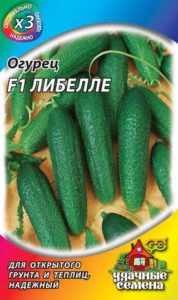
- A mid-season bee-pollinated hybrid that starts bearing fruit 49-52 days after germination.
- The plant is long-leaved.
- For cultivation in open ground, film shelters and greenhouses.
- The fruit is elongated-elliptical, small tuberous, dark green.
- Length - 12-14 cm, weight - 100-150 g.
- Productivity - up to 5-10 kg per sq.m.
- Possesses excellent appearance and taste.
- Universal use: salad and canning.
- Resistant to downy mildew, olive spot.
Lord F1
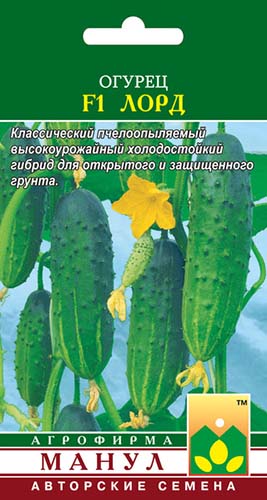
- Mid-season bee-pollinated hybrid. It starts bearing fruit 40-44 days after full germination.
- The plant is indeterminate, medium branched, female flowering type, the number of female flowers in a node is 1-2.
- For growing in open and protected ground.
- The fruit is small, with a short neck, fusiform, slightly ribbed, green with short stripes, large tuberous, white thorn.
- Length - 10-12 cm, weight - 90-120 g.
- Productivity - up to 9-13 kg per square meter
- Universal: pickling, canning and taste qualities are very high.
- It has good cold resistance. The hybrid is resistant to powdery mildew, olive spot, common cucumber mosaic virus, tolerant to downy mildew.
Kids from the garden F1
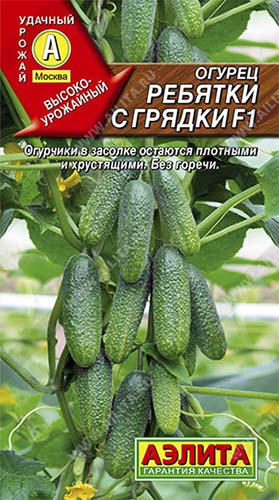
- Medium early bee-pollinated hybrid.
- The plant is indeterminate, vigorous, highly branched.
- For growing in the open field and under film shelters.
- Fruit is cylindrical, small tuberous, pubescence is white.
- Weight 100-110 g.
- Productivity - 9.0-9.6 kg per sq.m.
- The taste is excellent, without bitterness.
- Universal purpose. The fruits remain firm and crispy when preserved.
- Resistant to downy mildew, powdery mildew, olive spot and cucumber mosaic virus.
Spring F1
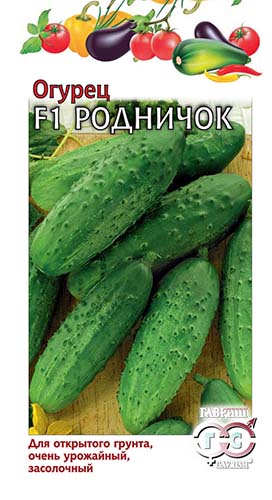
- Medium early (from germination to fruiting 40-48 days).
- A bee-pollinated hybrid of a predominantly female flowering type.
- For growing in the open field and under temporary cover films.
- The fruit is cylindrical, slightly elongated towards the base, green with light stripes, black and brown thorny, medium tuberous.
- Length - 9-10 cm, weight - 80-100 g.
- Productivity up to 5 kg from 1 plant.
- The taste is excellent.
- Ideal for pickling and preserving.
- Anthracnose resistant, relatively resistant to downy mildew, bacteriosis and olive spot.
Other bee-pollinated hybrids
There are an incredible number of hybrids of bee-pollinated cucumbers:
Note! Some firms sell the same hybrids(usually Dutch or Russian original selection).
- Productionfirm "Manul"(for open ground and greenhouses): Farmer F1, Maisky F1 (all the usual ones are classic), Alphabet F1, Acorn F1, Captain F1, Compass F1, Teremok F1, Saltan F1 (all with bunched ovaries). Relay F1, Olympiada F1, Manul F1 (ideal for preparing salads).
- Firm "Gavrish" sell a huge variety of bee-pollinated hybrids: Authority F1, Athlete F1, Bucks F1, Borovichok F1, Brigadier F1, Boomer F1, Valdai F1, Merry Notes F1, Blues F1, Uncle Fedor F1, Crane F1, Stash F1, Green Snake F1, King of the garden F1, Krakow F1, Cucuy F1, Kum da Kuma F1, Swallow F1, Maisky F1, Salted F1, Moravian Gherkin F1, Moskovsky Dude F1, Nasoli! F1, Otel F1, Cellar F1, Ambassador F1, Pososhok F1, Prince Mix F1, Razgulyay F1, Russian fun F1, RusCrust F1, Towel F1, Semcross F1, Slobodskoy F1, Nightingale F1, Tearaway F1, Topolek F1, Suitor F1, Khlebosolny F1, Khutorok F1, Gypsy F1, Chizhik F1, Southern Emerald F1, Fair F1.
- Firm"Aelita" sells no less quantity of bee-pollinated hybrids (Annushka F1, Appetizing F1, Aty-Bati F1, Afonya F1, Ajax F1 and many others).
- And other companies, for example, agricultural firms "Search", "Sedek", "Partner" (Baikonur F1, Zhuravlenok F1, Swallow F1, etc.).
- Also excellent bee-pollinated hybrids for open ground are (company "Semko"): Twixie F1, Understudy F1, Actor F1, Stuntman F1, Artek F1, Eaglet F1, Semcross F1.
Video: bee-pollinated cucumber hybrids for open ground (review of seeds of the company "Semko")
Bee-pollinated varieties of cucumbers: top-8
Elegant
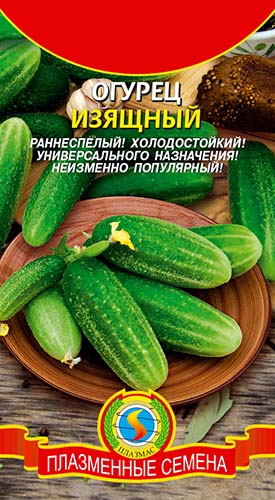
- An early maturing bee-pollinated variety (fruiting occurs in 40-50 days).
- The plant is medium-growing.
- For outdoor cultivation.
- Fruits are small lumpy, whitish.
- Length - 10-13 cm, weight - 140 grams (according to other sources, length -9-12, weight - 90-110 grams).
- Productivity - 1.1-7.2 kg per square meter (according to other sources 5-7 kg).
- Great taste. Perfect for both fresh consumption and for pickling, pickling, canning.
- Possesses high cold resistance. Resistant to olive spot.
Chinese snake

- Medium late bee-pollinated variety.
- The plant is powerful, intensively developing, with a long fruiting period.
- For growing outdoors using temporary cover films.
- To increase productivity, the main shoot is pinched after 6-7 leaves.
- The fruit is very long, up to 60 cm, serpentine, dark green, large, sparsely tuberous, with a short handle.
- Productivity with proper agricultural technology is up to 30 kg per sq. meter.
Chinese cucumber varieties are famous for their unsurpassed taste and aroma of fruits: sweet, juicy, without voids, with a thin delicate skin and small seed chambers - ideal for preparing fresh summer salads.
- The variety is picky about soil fertility; regular feeding is recommended.
Competitor
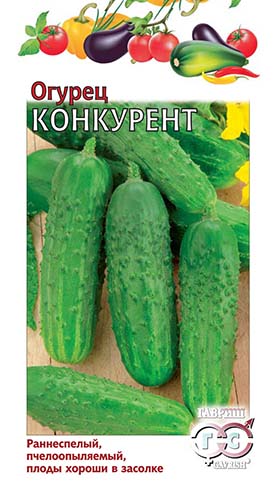
- Mid-season bee-pollinated variety (46-52 days from sowing to fruiting)
- The plant is highly branched, the length of the main whip is 140-200 cm.
- Designed for growing in open ground and under temporary film shelters.
- The fruit is oval-cylindrical, green with longitudinal light stripes, large lumpy, complex thorns, black.
- Length - 10-14 cm, diameter - 3.5-5 cm, weight - 65-95 g.
- Productivity - up to 7.8 kg per sq. meter.
- The taste is high.
- Mostly ideal for canning and pickling.
- Resistant to a complex of diseases.
Kid
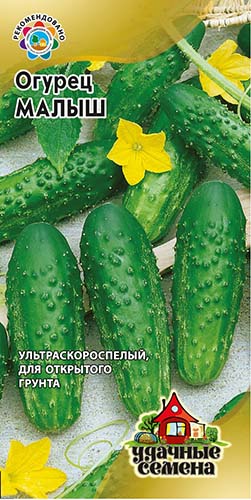
- Ultra-early maturing bee-pollinated variety (41-43 days from full germination to fruiting).
- The plant is bushy, compact (lash length 40-42 cm), slightly branched. Bundle arrangement of ovaries... Up to 6 ovaries are laid in the leaf axil.
- For growing in the open field and under temporary cover films.
- The fruit is elliptical, with large, sparse tubercles, with white pubescence,
- Length - 9-10 cm, weight - 80-115 g.
- Productivity - 3.4-3.9 kg per sq.m.
- Great taste. Used fresh and for canning.
Nezhinsky
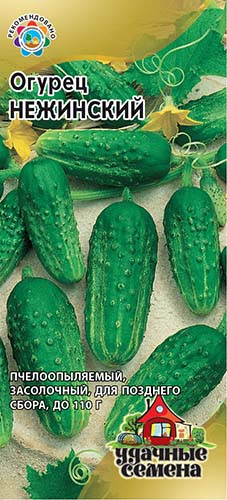
- Mid-season bee-pollinated variety (46-51 days from fruiting shoots).
- The plant is indeterminate, vigorous, highly branched, of a mixed type of flowering.
- Recommended for growing in open ground and under cover films.
- Fruits are short, ovate, green with stripes of medium length, large tuberous, black pubescence, rare.
- Length - 9-11 cm, weight - 80-110 g.
- Productivity - up to 4.9 kg per sq. meter.
- The taste is excellent.
- Universal use: salad, canning.
- Resistant to olive spot and cucumber mosaic virus.
Parisian gherkin
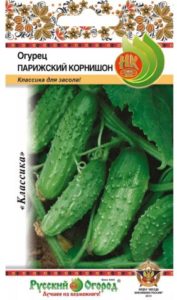
- Early maturing bee-pollinated variety (period from germination to the beginning of fruiting 38-45 days).
- The plant is indeterminate, medium-sized, medium-branched, mainly of the female flowering type. FROM beam the location of the ovaries.
- Designed for growing in open ground and under temporary film shelters.
- Fruits are short, fusiform, large tuberous, black-spined,
- 8-9 cm long, weight 60-80 g.
- Productivity - 3-4 kg per sq. meter.
- Excellent taste, no bitterness, dense, crunchy.
- Universal purpose. Ideal for cooking lightly salted, pickled and canned cucumbers.
- Resistant to true and downy mildew.
The variety is bunchy, which means it requires daily collection of gherkins.
Finger
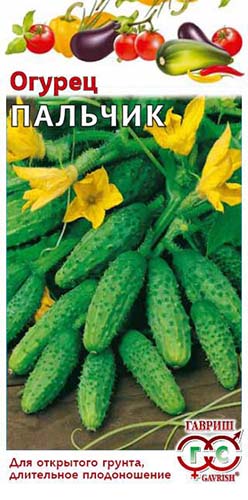
- Early maturing bee-pollinated variety (44-46 days from germination to fruiting).
- The plant is indeterminate, strongly plaited, medium-branched, with bundled ovaries.
- Recommended for outdoor cultivation.
- The fruit is elongated-cylindrical, dark green, with medium-length stripes and weak spotting, large tubercles, sparse tubercles, white pubescence.
- Length - 9.2-12.7 cm, diameter - 2.7-3.4 cm, weight -114-120 g.
- Productivity - 1.8-2.9 kg per sq. meter (in the open field).
- The taste is excellent.
- Universal use: for preparing salads, canned food, pickling.
- Differs in long-term fruiting - more than 60 days.
- Tolerant to downy mildew.
Phoenix 640
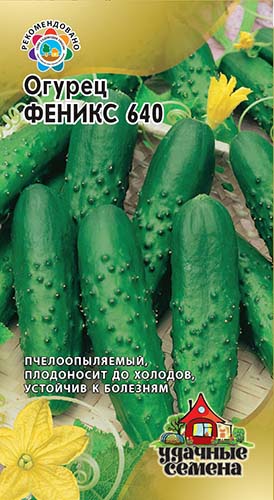
- Late ripening, fruiting 55-65 days after germination.
- Bee-pollinated variety.
- The plant is vigorous, the length of the main stem can reach 3 meters.
- Designed for growing in open ground and under temporary film shelters.
- The fruit is green, oval-cylindrical, with longitudinal light stripes, large lumpy, complex thorns, white.
- Length - 12-16 cm, weight - 120-180 g.
- Good taste.
- Salad: intended for fresh consumption.
- Possesses complex resistance to powdery mildew and cucumber mosaic virus.
- Differs in a long fruiting period.
Other bee-pollinated varieties
Also among the popular bee-pollinated varieties of cucumbers include:
- Stork;
- Altaic;
- Vyaznikovsky 37;
- Far East 27;
- Salting;
- Reliable;
- Monastic;
- Muromsky.
- Phoenix plus.
Thus, all you have to do is choose the bee-pollinated hybrid or cucumber variety that suits you best. Fortunately, now there is simply an incredible variety of them, which means that some of them will definitely be able to satisfy your desires. Experiment, plant, taste and find your personal best bee-pollinated variety or hybrid (or several).
Important! It is not enough just to choose a good variety, you must follow the cultivation techniques.
Video: the best bee-pollinated cucumber hybrids (from the agrofirm "Aelita")

